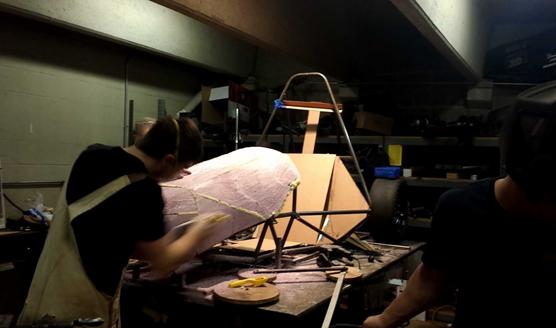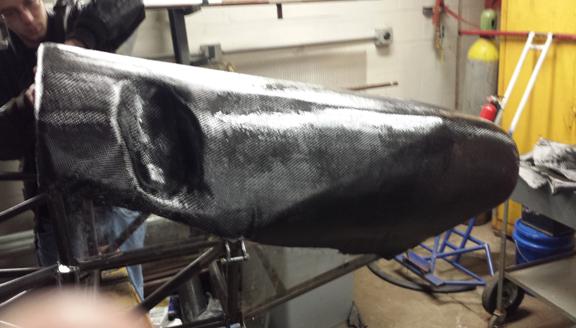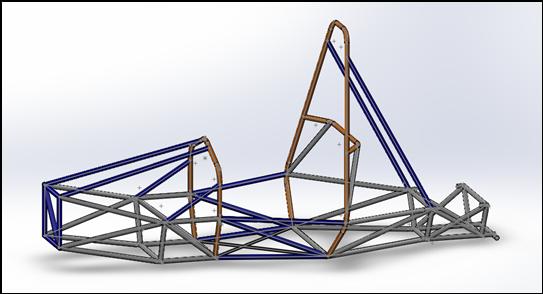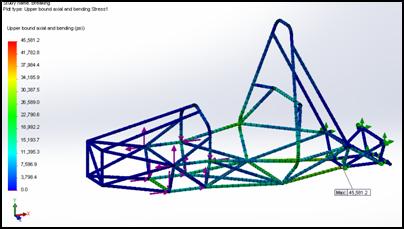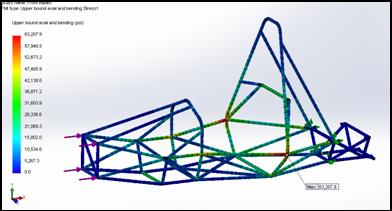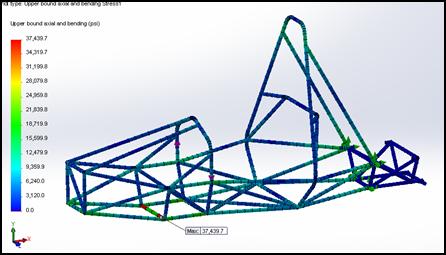
|
FRAME TEAM |
|
Wheelbase and track width--Load calcs—Ergonomics--Seat specs--Safety Equipment—Weight—Side pods A major design consideration for the frame is integrating a low center of gravity, which is critical for stability. The frame design is the result of several design iterations. The frame is sized to accommodate all team members, as well as the 95th percentile male driver, and recessing the position of the driver aids in the stability. Material used for the frame members is 4130 Chromoly steel alloy. This steel possesses high yield and tensile strength of 66 kpsi and 106 kpsi respectively, the primary structure of the frame is comprised of 1” outer diameter tubing with three different wall thicknesses Correct analysis of the suspension tabs is an essential part of a safe and reliable FSAE car. It is the one element connecting all suspension components to the frame and transfers all the forces from the wheels to the frame. This includes all braking, turning, and acceleration. These resultant forces drive the design and analysis of the tabs profile and thickness. The design requirement of a 2 g turn on the selected 3/16” thick tabs allowed for von mises stress levels to approach 32 ksi yielding a factor of safety of 2.1, this insures the integrity of the tabs during race conditions.
Frame Design The frame for this year’s FSAE car is the result of several design iterations. The frame is sized to accommodate all team members, as well as the 95th percentile male driver. In addition to sizing the frame to fit all team members, the majority of the frames rough design stems from the 2014 FSAE rules. The rules dictate the majority of the general frame design and specifications of the materials used. The material used for the frame members is 4130 Chromoly steel alloy. This steel possesses high yield and tensile strength of 66 ksi and 106 ksi respectively, which will increase the strength of the frame. The primary structure of the frame is comprised of 1” outer diameter tubing with three different wall thicknesses, which can be seen in Figure 1 below.
Figure 1: Frame tubing color coded identification. Gold: 1”x .095” Blue: 1” x .065” Gray: 1” x .049” The FSAE rule book specifies which type of tubing to use in each component of the frame. The three types of steel tubing outlined in the rule book are listed above in Figure 1, and were used in the proper areas of the car, as per the rule book. In order to determine if this frame satisfied various design criterion, the model was built in SolidWorks and was analyzed using SolidWorks Simulation. Four different simulations were performed on the frame to demine the displacements, factors of safety, and maximum stresses. Acceleration is one of the most important aspects for several of the dynamic events at the FSAE competition; therefore the frame was analyzed under acceleration conditions. When the car is accelerating the rear suspension box is primarily affected. Therefore the eight nodes in the rear suspension box where the tabs are mounted have a 2g force applied to them, as can be seen in Figure 2. The frame was fixed at the front eight suspension points, which can be seen by the green arrows in Figure 2. The forces create a clockwise moment about the suspension box, which can be seen in Figure 2. The maximum Von Mises stress found in the analysis is 16.3 ksi, which occurred at the lower forward node. This maximum stress gives a factor of safety of 4 and maximum displacement of .006 inches for the frame, which are acceptable values. These values confirm that the frame can handle the acceleration forces without failing, and that the forces will not cause the frame to deflect or deform.
Figure 2: 2g acceleration forces acting upon the rear suspension box. Similar to acceleration, breaking is equally as important in the dynamic events at the FSAE competition. Breaking forces cause the weight of the car to be transferred to the front of the car; therefore the eight front suspension points have a 2g forces applied to them and the rear eight suspension were fixed. This can be seen in Figure 3. The max Von Mises Stress resulting from the simulation was 45.58 ksi and a factor of safety of 1.46. The maximum stresses occur just outside the fixed points of the rear suspension box. The stresses are higher here because the analysis treats the fixes points as a rigid point, while the remaining beam is allowed to flex. Even with the larger stresses, the frame is beneath yield and will not fail.
Figure 3: 2g breaking forces acting upon the front suspension box. The frame was tested for a frontal impact, with a 5000 lbf load being applied to the front bulkhead of the frame with the impact attenuator in place. To complete this analysis the forward most rear suspension points were fixed and the load was applied evenly amongst the four nodes of the front bulkhead of the car, as seen in Figure 4. The impact attenuator will absorb 1574 lbf, which reduces the force distributed to the four nodes to 3426 lbf. This force is the result of a 15 mile per hour inelastic collision, where the vehicle comes to a complete stop in one second. The resulting Von Mises stress resulting from the simulation was 63.2 ksi with a factor of safety of 1.06. These values can be expected with an inelastic collision, where the vehicle collides perfectly normal with an immovable barrier. In a real world test the collision would not be inelastic and both the vehicle and barrier would have elastic properties. As can be seen in Figure 4, the stresses are concentrated in the members on the sides of the vehicle and not in front bulkhead. Therefore the frame will protect the drivers’ legs and not compress into the driver in the event of a frontal impact
Figure 4: 15 mph frontal impact of the frame. Cornering is another one of the important factors for the dynamic events at the FSAE competition. Hard cornering creates a moment about the centerline of the frame, and can affect the performance of the vehicle in tight turns. In general the more resistant the frame is to torsion, the better it will corner. The target torsional rigidity for this year’s frame is between 1000 to 2000 lb-ft/deg. The torsional rigidity for this frame has not been finalized due to an inconsistency in the calculation. In order to finalize this value the actual frame will be tested similarly to the procedures followed in the SolidWorks Simulation. In the simulation the forward points in the rear suspension box were fixed, and the two upper rear points in the front suspension box had a couple applied. This creates a moment about the centerline of the frame, twisting the frame and simulating hard cornering. The resulting Von Mises stress was 37.43 ksi in the bottom member connecting the lower nodes in the front suspension box. This force is approximately half of the yield strength and has a factor of safety of 1.78.
Figure 5: 2g torsional loading.
Failure Mode and Effects Analysis There are many design factors that go into the designing of a race car chassis, but no one is more important than safety. This is evident in the large set of rules for the FSAE competition. With every decision made on the car safety is always considered. The FMEA is a great way of inventorying safety concerns and will be utilized in the frame design. Having a budget for the project cost is also high on the list of deciding factors. Some designs or great ideas may have to be thrown out due to high cost as a compromise of an overall great car design within budget. Durability is also a factor, and relates closely to safety. The frame must be durable enough stand up to competition conditions without failing. Failing, depending on which component could result in harm to the driver or others. Also, this car is not meant to be discarded immediately after competition. It will remain with Bradley for at least the next year and serve and a test rig for future FSAE teams.
|
